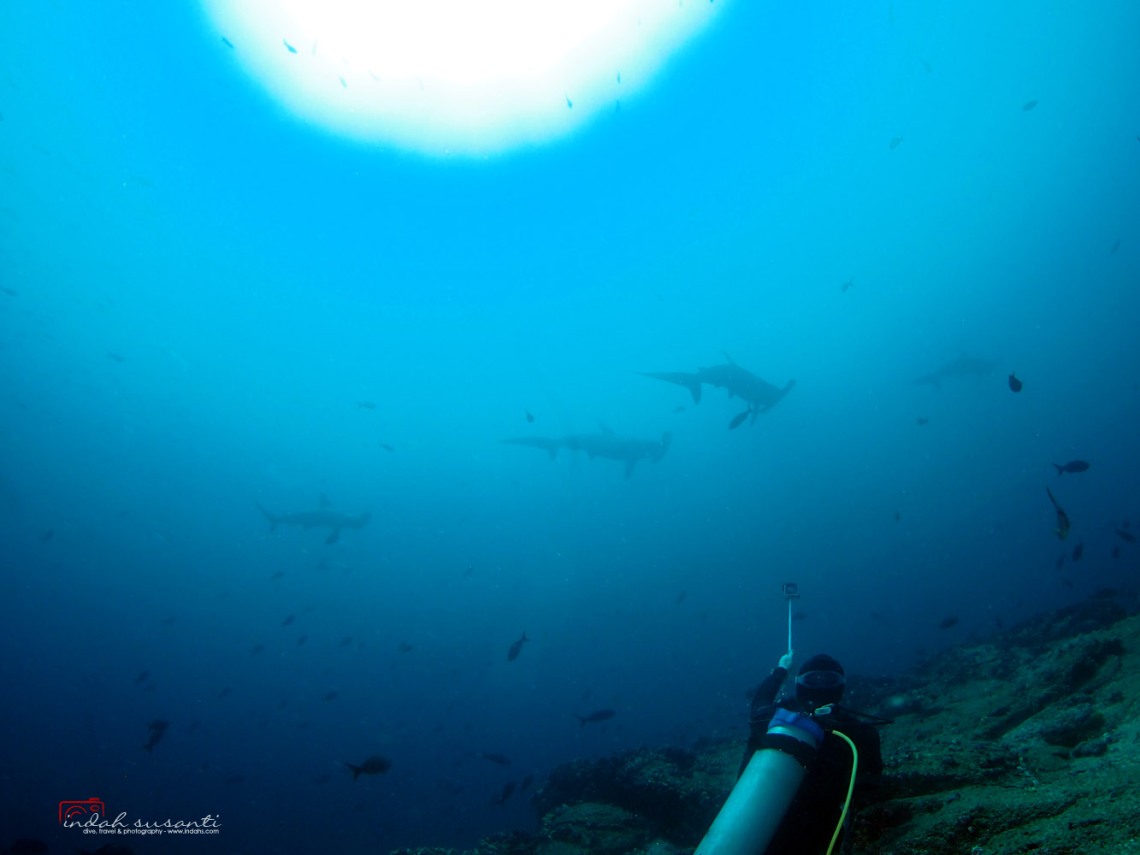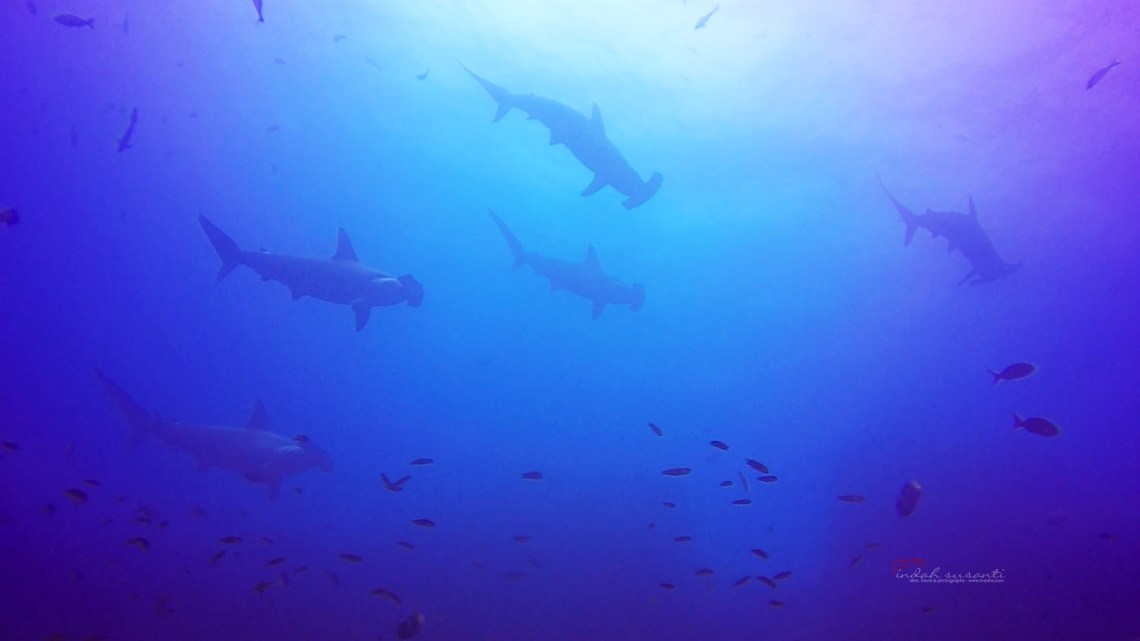Hammerhead Sharks in Galapagos (Ecuador)

34th edition of Marine Life monthly post. Marine Life post published every 19th of the month. It aims to share information about the marine life species and to promote their conservation. All images and videos in this post are taken by Indah Susanti unless stated otherwise.

Hammerhead sharks from distance. Wolf Island, Galapagos. Silence at its best: watching the wildlife while scuba diving.
First of all, let me assure you that majority hammerhead sharks are harmless to humans. From nine species of hammerhead sharks, only three species that considered dangerous. The most aggressive of the hammerhead species are scalloped hammerhead, whitefin hammerhead, and great hammerhead. However, there are rare fatalities caused by the hammerhead sharks. We were lucky to finally scuba diving with the hammerhead sharks in Wolf and Darwin Islands, Galapagos (Ecuador). We had been diving with them for four days and none of the scuba divers were attacked by the hammerhead sharks. The rule of thumb: leave them unprovoked, they will not harm you.
The Great Hammerhead and Scalloped hammerhead are endangered. Meanwhile, the rest of the hammerhead species numbers are decreasing and classified as vulnerable by IUCN Red List. In the year 2016, the government of Ecuador announced the creation of the marine sanctuary in Galapagos Islands that extends to the northern Galápagos islands of Darwin and Wolf. Fishing is not allowed in the Darwin and Wolf Islands. Darwin and Wolf Islands are known to have the largest concentration of hammerhead sharks especially the Scalloped hammerhead; migration pathway of the whales and numerous species of sharks. Not many places in the world where you can see the schooling of hammerhead sharks and these islands are ones of the few (the other location is in Cocos Island, Costa Rica). Thus the decision by the government of Ecuador to protect the two islands is highly appreciated.

Hammerhead sharks in group (Wolf Island, Galapagos)
Why should we conserve these animals? In addition to their high value as a resource for non-extractive activities such as tourism (WildAid, 2001), sharks play a very important role in marine environments. Most are top-level predators, meaning they feed on many animals but almost no other animal feeds on them. They help to maintain population stability of their prey, preventing disproportionate increases in their numbers and any resulting negative impacts on other marine organisms. (source)
Just like other sharks species, hammerhead sharks are at risk primarily due to over-fishing. Humans’ consumption of seafood often does not go along with the speed of the reproduction of the marine life. Reproduction of the hammerhead sharks only happens once a year. The process started the male shark biting the female shark violently until she agrees to mate. The female gives birth of 12 to 15 pups and the pups live by themselves at the young age. It’s very often the pups are the ones that get caught by the fishing industry. The lifespan for most Hammerheads is between 25 and 35 years and their diet are fish, lobster, crabs, squid, and octopuses.
Personally, I don’t get why people want to eat the sharks on the first place. Like most shark species, hammerheads urinate through their skin, so all of their body parts (include their fins) must have ammonia taste!
The most unique feature of the hammerhead sharks is their eyes that are set further apart by their unusual shaped head. Hammerhead shark has a 360-degree view – the shark can see the below, above, left, right at the same time. Imagine when you look at a 360-degree picture from that Samsung 360 Gear. However, the shark has a blind spot in front of their nose. (source)
Following is a video of a hammerhead shark in Galapagos that close enough to see its eyes.
After witnessing myself how gracious these sharks are, I wish more countries will follow Ecuador’s step to protect their waters. Since the sharks are migrating, it will be necessary to have protected zones on their migration path. Currently, the shark tagging project has helped to map the movement of the sharks. More about the conservation effort in Galapagos, please visit Charles Darwin Foundation. Fingers crossed, the hammerhead sharks will survive for the future generations.
Terrific images and post Indah. 👍
Thank you so much, Sherry!
So glad to have caught up with your remarkable and educational post. You have such fantastic photos and the video was certainly well worth watching. Inspired by your posts I have started a Pinterest board on ‘Life under the Sea’
Thank you so much, Diana! I am so happy to hear this from you 🙂 The life under the sea is certainly a fascinating one. Sometimes I wish humans can also breathe under the water without the SCUBA tanks 🙂
hi ndah.. selamat tahun baru yak.. btw gak serem ya? hahahah
Makasih yaaa..sama-sama, selamat tahun baru juga 🙂 Gak juga Nan. Hiu-hiunya kayaknya malah pada takut sama kita, setiap jarak deket langsung kabur gitu..lol
mungkin karena kalian gak cantik di mata mereka.#iyalah.. lol#
Hahahahahaha….kurang lezaat mungkin 😀 😀
Nahh this is what I’m waiting for! Keren banget foto2nya Mba, God’s creation is trully amazing. Semoga hiu2 ini tetap lesari. #savesharks
Terimakasih 🙂 Amiin..moga-moga hiu-hiu ini terus ada 🙂
Amazing!
Thank you so much!
Wonderful captures and great post Indah!!
Many thanks, Kirt! Truly happy to share the post with you 🙂
This is a wonderful post. I dove with the sharks in the Galapagos and loved it. My dive master was horrible,but that’s another story. Great blog. I even learned some new stuff, shark pee!
incredible! wow! I swam with a few local sharks but not hammerheads!